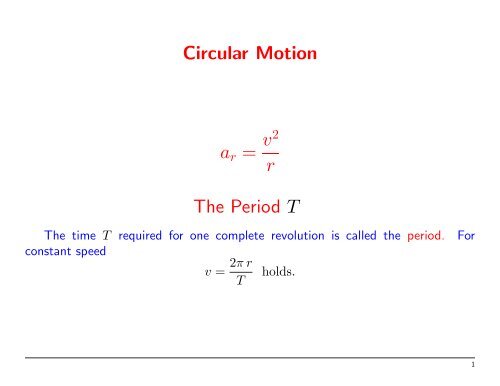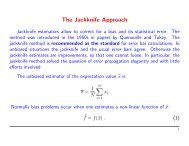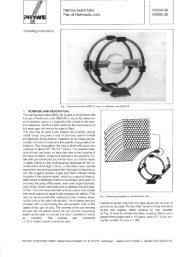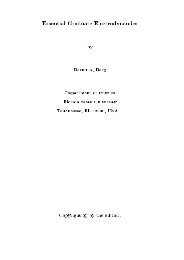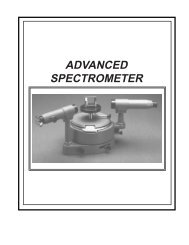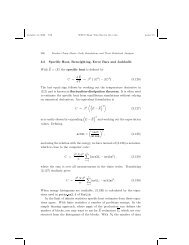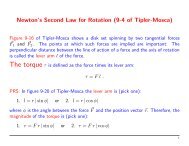Circular Motion v r The Period T
Circular Motion v r The Period T
Circular Motion v r The Period T
Create successful ePaper yourself
Turn your PDF publications into a flip-book with our unique Google optimized e-Paper software.
<strong>Circular</strong> <strong>Motion</strong><br />
a r = v2<br />
r<br />
<strong>The</strong> <strong>Period</strong> T<br />
<strong>The</strong> time T required for one complete revolution is called the period.<br />
constant speed<br />
v = 2π r holds.<br />
T<br />
For<br />
1
Example: <strong>Circular</strong> Pendulum: Figures 5-22 and 5-23 of Tipler-Mosca.<br />
between angle and velocity.<br />
Relation<br />
⃗T + ⃗ F cf + m⃗g = 0<br />
⃗T = T r ˆr + T y ŷ<br />
T r = −T sin(θ) = −m v2<br />
r<br />
T y = T cos(θ) = m g<br />
sin(θ)<br />
cos(θ) = v2<br />
g r<br />
tan(θ) = v2<br />
g r<br />
v = √ g r tan(θ)<br />
2
Example: Forces on a car in a banked curve:<br />
Figures 5-26 of Tipler-Mosca. <strong>The</strong> optimal angle θ is the one for which the<br />
centrifugal force is balanced by the inward component of the normal force (i.e.<br />
without friction). <strong>The</strong>n:<br />
F n cos(θ) − m g = 0<br />
F n sin(θ) − m v2<br />
r = 0<br />
tan(θ) = v2<br />
g r<br />
3
Angular Velocity<br />
Definition:<br />
ω = d θ<br />
d t<br />
For ω constant and in radian we find:<br />
v = r ω<br />
Namely, for one period:<br />
ω T = 2π ⇒ v T = 2π r<br />
4
Surface of Rotating Water<br />
Integration:<br />
parabola.<br />
dy(r)<br />
dr<br />
= tan(θ) = v2<br />
g r = ω2 r 2<br />
g r<br />
y(r) = ω r2<br />
2 g + y(0)<br />
= ω2 r<br />
g<br />
5
For the mathematically ambitious only:<br />
Another Derivation of the Acceleration<br />
Now,<br />
<strong>The</strong>refore,<br />
<strong>The</strong> velocity is<br />
⃗r(t) = r ˆr with ˆr = cos(θ) ŷ + sin(θ) ˆx<br />
θ(t) = ω t<br />
ˆr = cos(ωt) ŷ + sin(ωt) ˆx<br />
⃗v = d⃗r<br />
dt = r dˆr<br />
dt<br />
= −r ω sin(ωt) ŷ + r ω cos(ω t) ˆx<br />
where<br />
= −v sin(ωt) ŷ + v cos(ω t) ˆx = v ˆt<br />
ˆt = − sin(ωt) ŷ + cos(ω t) ˆx<br />
6
is the tangential unit vector. In the same way the acceleration follows:<br />
⃗a = d⃗v<br />
dt = v dˆt<br />
dt<br />
= −v ω cos(ωt) ŷ − v ω sin(ωt) ˆx<br />
= − v2<br />
r<br />
cos(ωt) ŷ −<br />
v2<br />
r<br />
sin(ωt) ˆx = −v2<br />
r ˆr<br />
⃗a = a r ˆr with a r = − v2<br />
r<br />
7
Questions on <strong>Circular</strong> motion<br />
A particle of mass m moves with constant speed v on a circle of radius R. <strong>The</strong><br />
following holds (pick one):<br />
1. <strong>The</strong> centripetal force is v 2 /R towards the center.<br />
2. <strong>The</strong> centripetal force is m v 2 /R towards the center.<br />
3. <strong>The</strong> centripetal force is m v 2 /R away from the center.<br />
4. <strong>The</strong> centripetal force is v 2 /R away from the center.<br />
5. <strong>The</strong> centripetal force is m v 2 /R downward.<br />
8
1. <strong>The</strong> acceleration of the particle is a constant vector.<br />
2. <strong>The</strong> acceleration of the particle is a vector of constant magnitude.<br />
3. <strong>The</strong> magnitude of the acceleration of the particle varies with time.<br />
1. <strong>The</strong> acceleration of the particle is a vector, which points up.<br />
2. <strong>The</strong> acceleration of the particle is a vector, which points down.<br />
3. <strong>The</strong> acceleration of the particle is a vector, which points towards the center of<br />
the circle.<br />
9
Drag Forces<br />
When an object moves through a gas like air or a fluid like water, it will be<br />
subject to a drag force or retarding force that reduces its speed.<br />
For an object which falls in air under the influence of gravity one observes an<br />
acceleration like<br />
m g − b v n = m a<br />
Where b is a constant and n is approximately one a low speed and two at high<br />
speeds.<br />
10
<strong>The</strong> terminal speed v term is reached for a = 0:<br />
b v n term = m g ⇒ v term =<br />
( m g<br />
) 1/n<br />
.<br />
b<br />
For n = 2:<br />
√ m g<br />
v term = .<br />
b<br />
Obviously, the terminal speed for a free fall in air is highly material dependent:<br />
E.g. a feather versus an iron ball, a man with our without a parachute.<br />
11
Questions<br />
v term =<br />
( m g<br />
) 1/n<br />
.<br />
b<br />
Determine b for an 80 kg object, n = 2 and v term = 200 km/h. <strong>The</strong> result is<br />
(pick one):<br />
1. b = 0.254 kg/m<br />
2. b = 0.254 kg/s<br />
3. b = 0.021 kg/s<br />
4. b = 0.021 kg/m<br />
12
Determine b for an 80 kg object, n = 1 and v term = 20 km/h. <strong>The</strong> result is<br />
(pick one):<br />
1. b = 141 kg/m<br />
2. b = 141 kg/s<br />
3. b = 39.2 kg/s<br />
4. b = 39.2 kg/m<br />
13


